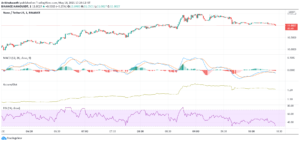
Oracles feed data from the outside world to a blockchain like Ethereum, such as the market price of cryptocurrencies or results of elections. The data can then be used by a smart contract on the blockchain to make decisions, such as whether or not to distribute money and to whom. Here is an example in more detail: Farmers frequently buy agricultural derivatives as insurance if their crops are destroyed by drought. If the weather doesn’t cooperate for the farmer one season, the derivative will compensate them with a lump sum payment. Oracles such as Chainlink and Band control the majority of Oracle’s market. Problems with Oracles The ability to run smart contracts is a defining feature of a blockchain like Ethereum. The smart contract is managed by the blockchain after it has been designed; no entity needs to be trusted to implement the rules. No intermediary can prevent the transaction from occurring as long as the smart contract’s criteria are met. The contract merely executes the instructions given to it. On the other hand, Oracle is a data stream managed by an entity. For Example, a weather oracle. Although blockchains like Ethereum were designed to exclude third parties. Putting your faith in a data source can lead to problems. For Example, the owner of an oracle’s data stream could upload incorrect data to sway smart contracts in their favour. Someone might even hijack the data flow to skew the results in their favour. This isn’t an issue for smart contracts that aren’t reliant on oracles. Researchers are looking into different ways to mitigate this problem, such as creating oracles that are more decentralized or otherwise safeguarded from malicious actors. Oracle computers using Trusted Execution Environments (TEEs), unique hardware portions with added security, making them harder to tamper with, is one such area of research. Two types of Oracles Centralized Oracles A single entity controls centralized oracles, which serve as the sole data source for smart contracts. They demand that smart contract participants place a high level of faith in a single organization. They also constitute a single point of failure, which might jeopardize a smart contract’s security. If an oracle is compromised, the smart contract is as well. Smart contracts’ accuracy and usefulness are strongly reliant on the quality of data they are given. Therefore oracles retain a significant level of control over them. Smart contracts were created to prevent counterparty risk and excessive reliance on third parties. Oracles allow contracts between untrustworthy parties to execute, but they risk becoming the middlemen they were supposed to replace (especially if they become over-centralized). The protection of privacy, security, and fairness and avoiding over-centralization, which could harm the interaction between smart contracts and blockchains, is referred to as the oracle problem. Decentralized Oracles Decentralized oracles strive for trustlessness and deterministic outcomes based on cause and effect rather than individual relationships. They try to achieve these goals in the same way a blockchain network does: by distributing trust across many network participants. Decentralized oracle networks can strengthen the security and fairness of smart contracts by using several data sources and constructing an oracle system that a single party doesn’t control. Similarly to any other third party, centralized oracles can become compromised and susceptible to manipulation. As a result, many blockchain projects are building (or have established) decentralized oracles, including Chainlink (LINK), Band Protocol (BAND), Augur (REP), and MakerDAO (makers of DAI). Decentralized oracles’ ability to address the oracle problem and dramatically increase the use cases of smart contracts across a wide range of markets is an exciting and ongoing development for cryptocurrencies and the blockchain industry. Most Used Oracles in web3 Chainlink The most widely utilized oracle network for connecting blockchain networks and smart contracts to real-world data resources is Chainlink. The network’s native token, LINK, is used to pay for usage. It uses a single framework to connect all major private and public blockchains and allow cross-network communication. Advantages of Chainlink It’s a decentralized oracle with a large capacity for extension. The protocol’s extensible foundation allows it to offer information on nearly anything. The system is decentralized, and it was designed with security and the accuracy of the data being provided in mind. The installation of Chainlink nodes is straightforward, allowing for the rapid expansion of the network’s node network. The protocol’s economic architecture allows anyone with a node in the network to make a good amount of profits by selling services to others who utilize the protocol. The system is open-source software that can be verified in any configuration. Band Protocols Band Protocol is a cross-chain data oracle platform that aggregates and integrates real-world data and APIs to smart contracts in a decentralized manner. The protocol uses BandChain, an independent blockchain created exclusively for oracle computations such as settlement, data sourcing, … Continued
The post Oracles – A Bridge Between Real World and Blockchains appeared first on Cryptoknowmics-Crypto News and Media Platform.
- "
- About
- across
- address
- advantages
- All
- Allowing
- Although
- amount
- anyone
- APIs
- architecture
- AREA
- become
- being
- Block
- blockchain
- blockchain industry
- blockchain projects
- BRIDGE
- Building
- buy
- Capacity
- cases
- Cause
- centralized
- Chainlink
- chainlink (link)
- Communication
- computers
- Configuration
- constitute
- contract
- contracts
- control
- could
- Counterparty
- created
- Creating
- crops
- Cross-Chain
- cryptocurrencies
- DAI
- data
- decentralized
- Demand
- Derivatives
- destroyed
- detail
- Development
- different
- Display
- distributing
- Doesn’t
- dramatically
- Economic
- effect
- Elections
- especially
- established
- ethereum
- example
- execution
- expansion
- Failure
- farmers
- Feature
- First
- flow
- Foundation
- Framework
- Goals
- good
- Hardware
- here
- High
- hijack
- HTTPS
- implement
- Including
- Increase
- individual
- industry
- information
- insurance
- interaction
- issue
- IT
- large
- lead
- Level
- LINK
- Long
- looking
- major
- Majority
- MakerDao
- Making
- managed
- manner
- Market
- Markets
- Media
- middlemen
- mind
- money
- more
- most
- network
- networks
- news
- nodes
- offer
- oracle
- organization
- Other
- otherwise
- owner
- participants
- Pay
- payment
- platform
- Point
- price
- privacy
- private
- Problem
- problems
- profits
- projects
- protection
- protocol
- protocols
- public
- quality
- range
- real world
- Relationships
- reliance
- research
- researchers
- Resources
- Results
- Risk
- rules
- Run
- security
- Services
- settlement
- significant
- Similarly
- smart
- smart contract
- Smart Contracts
- Software
- Someone
- stream
- system
- third parties
- token
- transaction
- Trust
- unique
- use
- utilize
- Web3
- whether
- WHO
- world











